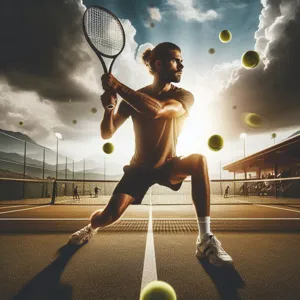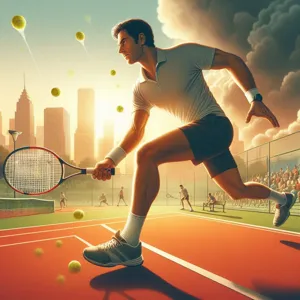Tennis, a sport that blends athleticism, strategy, and finesse, can be both exhilarating and challenging.
Whether you’re a novice stepping onto the court for the first time or a seasoned player looking to refine your skills, mastering the fundamental techniques is crucial to elevating your game. From perfecting your grip and footwork to understanding the nuances of strokes and serves, the basics lay the foundation for consistent performance and improvement. In this blog post, we’ll explore essential fundamentals that every tennis player should embrace, offering insights and tips to help you develop a strong skill set, enhance your confidence, and ultimately transform your playing style. Join us as we delve into the core elements of the game that will empower you to take your tennis journey to the next level!
1. Introduction to Tennis Fundamentals

Tennis, often described as a beautiful blend of athleticism, strategy, and precision, is a sport that captivates players and spectators alike. Whether you’re picking up a racket for the first time or looking to refine your skills, understanding the fundamentals of tennis is crucial to elevating your game. In this section, we will explore the foundational aspects that every player should grasp to build a solid tennis repertoire.
At its core, tennis involves mastering several key components: grip, stance, footwork, and stroke mechanics. The grip you choose can significantly influence your shot execution, while your stance lays the groundwork for balance and power. Footwork, often overlooked by beginners, is essential for positioning yourself effectively on the court, allowing you to reach the ball with agility and control. Finally, the mechanics of your strokes—the forehand, backhand, serve, and volley—create the rhythm of your game and are vital for consistency and accuracy.
Understanding these fundamentals not only enhances your performance but also instills confidence as you step onto the court. Each session spent perfecting these skills contributes to a deeper appreciation of the sport, as well as a sense of accomplishment that fuels your passion for tennis. As we delve deeper into each fundamental aspect, you’ll discover how they interconnect and contribute to a more enjoyable and successful playing experience. So, grab your racket, and let’s embark on this journey to master the basics of tennis!
2. The Importance of Grip: Finding Your Perfect Hold
In the world of tennis, your grip is more than just a hold on the racket; it’s the foundation of your entire game. The right grip can elevate your performance, enhancing your power, control, and comfort on the court. When selecting a grip, consider both the type of racket you are using and your unique playing style.
There are several types of grips, including the Eastern, Western, and Continental grips, each offering distinct advantages depending on the shot you wish to execute. For instance, the Eastern grip is favored for its versatility, allowing players to strike the ball with both topspin and flat shots effectively. On the other hand, the Western grip offers maximum topspin, making it ideal for those who prefer a more aggressive baseline game.
Finding your perfect grip is a process of experimentation. Begin by holding the racket as if you were shaking hands with it—this is often referred to as the “handshake grip.” From there, adjust the placement of your fingers and the pressure you apply to discover what feels most comfortable. It’s crucial to maintain a relaxed hold; gripping too tightly can lead to fatigue and hinder your movement.
Additionally, pay attention to the size of your racket’s grip. A grip that’s too small can cause your hand to twist during swings, while a grip that’s too large can lead to tension in your arm. Use the index finger test: when holding the racket, there should be just enough space to fit your index finger in the gap between your fingers and palm.
As you practice, try out different grips during drills and matches. Notice how your shots respond and how your timing improves with the right hold. Remember, mastering your grip is not just about technique; it’s about building confidence on the court. With the perfect grip, you’ll find yourself hitting with more precision, generating greater power, and ultimately enjoying the game even more.
3. Mastering Strokes: Forehand and Backhand Techniques

Mastering strokes is crucial for any aspiring tennis player, as the forehand and backhand are fundamental to achieving consistency and power on the court. These two strokes form the backbone of your game, allowing you to control rallies, dictate play, and ultimately outmaneuver your opponent.
**Forehand Technique**: The forehand is often considered the most powerful shot in tennis, and mastering it can give you a significant advantage. Start by positioning yourself with your feet shoulder-width apart and knees slightly bent. Grip your racket with a comfortable Eastern or Western grip, which will allow for optimal spin and control. As the ball approaches, pivot your body and rotate your hips, transferring weight from your back foot to your front foot. Swing your racket low to high, making contact with the ball at waist height. Finish your stroke with your racket over your shoulder, ensuring you follow through completely. This fluid motion not only adds power but also ensures accuracy, allowing you to place the ball precisely where you want it to go.
**Backhand Technique**: The backhand can be a challenging stroke for many players, but with practice, it can become just as formidable as the forehand. You have the option to use a one-handed or two-handed backhand, so choose the style that feels most comfortable for you. For a two-handed backhand, grip your racket with your dominant hand on the bottom and your non-dominant hand above it. As you prepare to hit, turn your shoulders and step into the shot, using your legs to generate power. Make contact with the ball slightly in front of your body, and remember to swing from low to high, just as you would with a forehand. For a one-handed backhand, maintain a firm grip and rely on your upper body strength to generate power, using your non-dominant hand to help guide the racket. Finish with your racket high, allowing for a full follow-through that enhances both control and spin.
By dedicating time to perfecting your forehand and backhand techniques, you’ll lay a solid foundation for more advanced strokes and tactics. Regular practice, combined with the right drills and feedback, will not only improve your strokes but also bolster your confidence on the court, ultimately elevating your overall tennis game. Remember, mastery comes with patience and persistence—so keep drilling and watch as your skills transform!
4. The Art of Serving: Keys to a Powerful Serve
The serve is often considered the most critical shot in tennis, setting the tone for the entire point and establishing dominance on the court. Mastering the art of serving involves not just power, but also precision, placement, and strategy. Here are some keys to developing a powerful serve that can elevate your game to new heights.
**Grip and Stance**: The foundation of a strong serve begins with the right grip and stance. The continental grip is widely recommended for its versatility, allowing you to execute various types of serves, from flat to slice. Position your feet shoulder-width apart, with your non-dominant foot slightly ahead. This stance not only provides balance but also generates the necessary torque as you initiate your motion.
**Tossing the Ball**: A consistent ball toss is essential for a reliable serve. Aim to toss the ball slightly in front of you and to the right (for right-handed players), ensuring that it reaches its peak just as your racket makes contact. Practice your toss separately to develop muscle memory; a well-placed toss can make all the difference in achieving the desired serve.
**The Motion**: As you begin your serve, focus on a smooth, fluid motion. Start with a relaxed shoulder turn and bend your knees slightly for leverage. As you swing upward, transfer your weight from your back foot to your front foot, generating power from your legs and core. Follow through with your racket, finishing high above your shoulder to ensure maximum speed and spin.
**Types of Serves**: Experimenting with different types of serves can keep your opponent guessing. A flat serve is powerful and direct, while a slice serve can pull your opponent wide off the court. A kick serve adds an element of surprise, bouncing high and making it difficult for opponents to return aggressively. Mastering these variations will not only enhance your serve but will also contribute to your overall strategic play.
**Practice, Practice, Practice**: Like any skill in tennis, improving your serve requires dedicated practice. Set aside time during each training session to focus exclusively on your serving technique. Record yourself or seek feedback from a coach to identify areas for improvement. Consistency will come with repetition, and soon, you’ll find yourself serving with both confidence and power.
By honing these fundamental aspects of the serve, you’ll not only increase your effectiveness on the court but also instill a sense of confidence in your overall game. A powerful serve can be your secret weapon, allowing you to dictate play and put pressure on your opponents right from the very first point.
5. Footwork Fundamentals: Moving Like a Pro

Footwork is the unsung hero of a successful tennis game. Many players focus heavily on their swings and techniques, often overlooking the foundational necessity of effective movement on the court. However, mastering your footwork can be the difference between landing a powerful shot and sending the ball soaring out of bounds. To move like a pro, you need to develop a keen sense of balance, agility, and speed, all of which stem from solid footwork fundamentals.
Start with the ready position: feet shoulder-width apart, knees slightly bent, and weight balanced on the balls of your feet. This stance not only prepares you to react swiftly to your opponent’s shot but also allows for quick lateral movement. A common mistake is to remain flat-footed or overly tense; instead, practice staying light on your feet, ready to spring into action.
Once you’re in the ready position, focus on your positioning for each shot. Use short, quick steps to adjust your feet and maintain a low center of gravity, which enhances your stability. Rather than relying on long strides, which can slow you down, work on taking smaller, precise steps that keep you agile and able to change direction with ease. Incorporating drills that emphasize lateral movement, such as shuffling side to side or practicing split steps, will further sharpen your footwork.
Don’t forget about the importance of anticipation. A good player doesn’t just react to the ball; they predict where it’s going. By observing your opponent’s body language and shot preparation, you can position yourself effectively, thus reducing the distance you need to cover. This proactive approach allows you to conserve energy and maintain your stamina throughout the match.
Finally, practice makes perfect. Dedicate time during your training sessions to focus solely on footwork drills. Whether it’s ladder drills, cone drills, or simply practicing your movement patterns, repetition will engrain these fundamentals into your muscle memory. With improved footwork, you will not only enhance your overall performance but also gain a competitive edge, enabling you to respond to every shot with confidence and precision. Mastering the art of movement will elevate your game to new heights, ensuring you’re always in the right place at the right time.
6. Understanding Court Positioning: Where to Stand
Understanding court positioning is a fundamental skill that can significantly elevate your tennis game. The right stance not only enhances your ability to respond to your opponent’s shots but also sets the stage for your own offensive plays. Whether you’re at the baseline or approaching the net, knowing where to stand at any given moment can make all the difference.
When positioned at the baseline, your focus should be on maintaining a solid stance that allows for quick lateral movement. Ideally, you want to stay a few feet behind the baseline, giving yourself ample space to react to deep shots while still being able to step in and attack shorter balls. Your feet should be shoulder-width apart, knees slightly bent, and weight distributed evenly, ready to spring into action. This position not only helps you defend against powerful serves but also prepares you for aggressive returns.
As you move closer to the net, your positioning must adapt. The transition from baseline to net play requires a keen sense of timing and spatial awareness. When approaching the net, aim to position yourself within striking distance of the service box, allowing you to intercept volleys effectively. Be mindful of your opponent’s position and anticipate their shots; this will enable you to cut off angles and put pressure on them, forcing errors or weak returns.
Additionally, understanding the dynamics of court angles is crucial. When your opponent is wide on one side, shift accordingly to cover the open court. This not only minimizes the risk of being caught out of position but also maximizes your ability to create opportunities for winning shots. Remember, effective positioning isn’t just about where you stand; it’s about being adaptable and responsive to the game’s flow.
Ultimately, mastering court positioning requires practice and a keen sense of awareness during matches. By honing this skill, you’ll find yourself not only more prepared to respond to your opponent’s moves but also in a better position to dictate the pace and direction of the game. Understanding where to stand can transform your play, making you a more formidable opponent on the court.
7. The Role of Mental Toughness in Tennis

In the high-stakes world of tennis, where every serve, volley, and rally can hinge on a razor-thin margin, mental toughness emerges as a pivotal factor that separates the good from the great. It’s not just about physical prowess; the mental aspect of the game can often determine who walks away with the trophy and who leaves the court with their head hung low.
Mental toughness encompasses a variety of skills and attributes, including focus, resilience, and the ability to manage pressure. Imagine being in the final set of a crucial match, with your opponent relentlessly challenging your every shot. It’s in these moments that mental fortitude is truly tested. A player with strong mental toughness can maintain composure, strategize effectively, and harness their nerves to fuel their performance rather than hinder it.
Visualization techniques play a critical role in building this mental strength. Many elite players spend time imagining themselves executing perfect serves, hitting winning shots, and celebrating victories. This mental rehearsal not only boosts confidence but also prepares the psyche for real match scenarios. Additionally, practicing mindfulness and breathing exercises can help players stay present and focused, minimizing the impact of distractions and negative thoughts.
Moreover, developing a growth mindset is essential for cultivating mental toughness. Embracing challenges, learning from mistakes, and viewing setbacks as opportunities for improvement can transform the way a player approaches both practice and competition. Rather than succumbing to the pressure of a crucial point, mentally tough athletes view it as a chance to showcase their skills and resilience.
Ultimately, mastering the basics of mental toughness can elevate a player’s game to new heights. It equips them with the tools to handle the inherent ups and downs of tennis, allowing them to push through adversity and thrive in high-pressure situations. In a sport where every match is a test of character as much as skill, investing in mental toughness is not just beneficial—it’s essential for any player aspiring to reach their full potential on the court.
8. Effective Strategies for Different Playing Styles
Tennis is a diverse sport, and mastering it requires an understanding of various playing styles and the strategies that complement each. Whether you identify as an aggressive baseliner, a serve-and-volley player, or a counterpuncher, tailoring your approach to your strengths is crucial for elevating your game.
For aggressive baseliners, the focus should be on dictating the pace of play. This style thrives on powerful groundstrokes and a willingness to take risks. Effective strategies include hitting deep, penetrating shots that push your opponent back and setting up for a decisive winner. Incorporate consistent footwork drills to enhance your positioning, enabling you to strike with both power and precision.
Serve-and-volley players, on the other hand, need to emphasize quick transitions from the baseline to the net. A strong serve is paramount, and following it up with swift movement towards the net can put immediate pressure on your opponent. Practice your volleys and overheads to ensure you capitalize on every opportunity to finish points early. Additionally, mastering the art of reading your opponent’s shot can help you anticipate their returns, positioning you advantageously at the net.
For counterpunchers, the strategy revolves around consistency and patience. This style requires an acute awareness of the opponent’s weaknesses and a knack for prolonging rallies. Focus on developing a rock-solid defensive game that allows you to retrieve balls and create openings for counterattacks. Incorporate drills that improve your agility and reaction times, giving you the edge in long exchanges.
Each playing style has its unique strengths and weaknesses, but understanding these fundamentals allows for a more strategic approach to your matches. Regularly assess your own game and your opponents to adapt your strategies accordingly. By embracing effective tactics suited to your playing style, you will not only enhance your performance on the court but also gain a deeper appreciation for the intricacies of the game.
9. Building Endurance: Conditioning for Tennis
Building endurance is a fundamental pillar for any tennis player looking to elevate their game. Tennis is a physically demanding sport that requires a unique blend of speed, agility, and sustained stamina. As you race across the court, lunging for balls and executing powerful serves, having a solid foundation of endurance will not only enhance your performance but also significantly reduce your risk of injury.
To effectively condition for tennis, focus on a well-rounded fitness regimen that includes cardiovascular training, strength building, and flexibility exercises. Start with aerobic activities such as running, cycling, or swimming to increase your heart rate and improve your overall stamina. Aim for at least 30 to 45 minutes of these activities several times a week, gradually increasing the intensity and duration as your fitness levels improve.
Incorporate interval training into your routine to mimic the short bursts of energy required during matches. For example, alternate between high-intensity sprints and lower-intensity jogging, allowing your body to adapt to fluctuating exertion levels. This method not only boosts your endurance but also enhances your recovery time, enabling you to maintain peak performance throughout long matches.
Strength training is another vital aspect of conditioning for tennis. Focus on exercises that target the muscles used during play, such as your legs, core, and upper body. Squats, lunges, planks, and resistance band exercises can help build the strength necessary for powerful strokes and quick movements. Additionally, don’t underestimate the importance of flexibility; incorporating yoga or dynamic stretching can improve your range of motion and prevent injuries.
Finally, listen to your body and ensure you are allowing adequate recovery time. Endurance isn’t built overnight, and overtraining can lead to fatigue and burnout. With consistent effort and a balanced approach to conditioning, you’ll find yourself not only lasting longer on the court but also playing with greater confidence and energy. Building endurance is not just about physical conditioning; it’s about enhancing your mental toughness and resilience, allowing you to outlast your competition, one rally at a time.
10. Common Mistakes and How to Fix Them
When it comes to improving your tennis game, recognizing and correcting common mistakes is a crucial step toward mastery. Even the most seasoned players can slip into bad habits that hinder their performance. Here are some frequent missteps and practical solutions to help you elevate your game.
**1. Poor Grip Awareness**
One of the most fundamental errors players make is using the wrong grip for their shots. This can lead to inconsistent ball striking and reduced power. To fix this, dedicate time to understanding the various grips—such as the Eastern, Western, and Continental grips—and practice using each one in appropriate situations. Experimenting with them during practice sessions will help you find what feels most comfortable and effective for your playing style.
**2. Inadequate Footwork**
Many players struggle with their footwork, often becoming flat-footed or failing to move into position quickly enough. This can lead to missed shots and a lack of control. To improve your footwork, incorporate agility drills into your training routine, such as ladder drills or cone sprints. Focus on maintaining a low center of gravity and staying light on your feet, allowing for quicker reactions and smoother transitions between shots.
**3. Neglecting the Follow-Through**
A common mistake is not following through properly after hitting the ball. This can result in shots that lack power and accuracy. To fix this, consciously practice your follow-through during drills. Make sure your racket continues its motion after contact with the ball, extending towards your target. This not only enhances shot precision but also contributes to a more fluid and effective swing.
**4. Overgripping the Racket**
Tension and overgripping the racket can lead to fatigue and decreased racket head speed, adversely affecting your shots. To alleviate this, focus on maintaining a relaxed grip. Practice holding the racket with just enough pressure to control it without straining your hand. This will enable you to generate more power and finesse in your strokes.
**5. Ignoring the Mental Game**
Lastly, many players overlook the importance of mental toughness in tennis. Stress and anxiety can lead to unforced errors and poor decision-making during matches. To strengthen your mental game, incorporate visualization techniques and mindfulness practices into your training. Before matches, take a moment to visualize your success on the court, and practice breathing exercises to stay calm under pressure.
By identifying these common mistakes and implementing targeted strategies to correct them, you’ll be well on your way to enhancing your skills and enjoying a more successful and fulfilling tennis experience. Remember, mastery is a journey, and with dedication and awareness, you can transform your game from ordinary to extraordinary.
11. Practicing Drills to Reinforce Basics
Practicing drills to reinforce the basics is an essential component of any serious tennis player’s training regimen. While it may be tempting to jump straight into match play or advanced techniques, dedicating time to foundational drills can significantly enhance your overall game. These drills not only help solidify your grip, footwork, and stroke mechanics but also build muscle memory that will serve you well during high-pressure points in a match.
One effective drill is the **shadow swing**, where you practice your strokes without a ball. This allows you to focus entirely on your form and technique, ensuring that your grip is correct and your follow-through is smooth. Pair this with footwork drills, such as ladder exercises or cone sprints, to improve your agility and positioning on the court.
Another valuable practice drill is the **target practice** exercise, where you place cones or targets in specific areas of the court and aim to hit them consistently. This not only improves your accuracy but also helps you develop a strategic mindset, as you learn to place your shots where they will be most effective against an opponent.
Don’t forget about practicing your serve, which is often considered the most crucial shot in tennis. Set aside time for **serve drills** that focus on different types of serves—flat, kick, and slice. By honing your serve through repetitive practice, you’ll boost your confidence and effectiveness when it counts.
Incorporating these drills into your training routine will not only reinforce your foundational skills but also create a solid platform from which you can explore more advanced techniques. Remember, mastering the basics is the key to elevating your game and achieving long-term success on the court.
12. The Importance of Consistency Over Power
When it comes to tennis, many players often fall into the trap of believing that sheer power is the key to success on the court. While hitting the ball with force can be impressive, it’s the consistency of your shots that truly defines a great player. Mastering the basics means understanding that a powerful serve or forehand is only effective if you can reliably place it within the lines, time after time.
Imagine a match where a player is able to unleash a powerful serve but consistently follows it up with erratic returns. The opponent, on the other hand, may not hit the ball as hard, but their groundstrokes are precise and reliable. Over the course of the game, the latter player will likely prevail. This is because consistency builds confidence, making it easier to maintain focus and execute strategies during critical points.
To cultivate consistency, it’s essential to focus on your technique. Rather than swinging for the fences, concentrate on your footwork, grip, and follow-through. Regularly practice drills that emphasize accuracy over power; target specific areas of the court during your training sessions. Gradually, you’ll find that as your consistency improves, so will your ability to generate power naturally, without sacrificing placement.
In tennis, matches are often won by the player who makes fewer unforced errors. By prioritizing consistency, you’ll not only enhance your game but also develop the mental fortitude to stay composed under pressure. This fundamental approach not only sharpens your skills but also helps you build a lasting love for the game, allowing you to enjoy each match, regardless of the outcome. So, next time you hit the court, remember: it’s not about how hard you hit, but how well you hit it, time and again.
13. Analyzing Professional Players: Learning from the Best
Analyzing professional players is a powerful way to elevate your own tennis game. The world of professional tennis is filled with talent, skill, and strategy, making it a treasure trove of learning opportunities for aspiring players. When you take the time to watch matches, pay close attention not just to the score but to the nuances of each player’s style and technique.
Start by selecting a few of your favorite professionals—perhaps the power-hitting of a player like Rafael Nadal or the graceful precision of Roger Federer. As you watch their matches, focus on their footwork. Notice how they position themselves to hit the ball, how they anticipate their opponent’s moves, and how they recover after each shot. This level of awareness will help you understand the importance of movement and positioning on the court, allowing you to implement similar strategies in your own game.
Additionally, analyze their shot selection. Professional players are masters at reading the game and making split-second decisions. Observe how they choose to play aggressive or defensive, when they opt for a drop shot versus a deep baseline shot, and how they exploit their opponent’s weaknesses. Keep a notepad handy or use a digital app to jot down key moments and strategies that resonate with you.
Don’t forget to take advantage of replay features on streaming services or specialized tennis analysis platforms. Slowing down the action can reveal intricacies that are easily missed during a live match. Look for patterns in their gameplay, such as preferred serves or rally tactics that lead to winning points.
Finally, consider integrating the lessons learned from these professionals into your practice sessions. Try to replicate their serves, groundstrokes, or even their mental toughness in your own drills. This kind of analysis not only enhances your technical skills but also instills a deeper understanding of the game as a whole. By learning from the best, you’ll not only improve your performance but also develop a richer appreciation for the sport itself.
14. Setting Goals for Improvement and Progress Tracking
Setting goals for improvement and tracking your progress is a fundamental aspect of elevating your tennis game. Without a clear vision of what you want to achieve, it becomes easy to lose motivation and direction. Begin by identifying both short-term and long-term goals. Short-term goals might include mastering a specific stroke or improving your serve percentage during practice matches, while long-term goals could involve reaching a certain ranking or competing in a local tournament.
Once you’ve established your goals, it’s crucial to make them SMART—Specific, Measurable, Achievable, Relevant, and Time-bound. For instance, instead of simply saying, “I want to improve my backhand,” you could set a goal like, “I want to consistently hit my backhand over the net 80% of the time during practice sessions over the next month.” This clarity not only provides you with a concrete target but also helps you stay focused and dedicated.
As you work towards your goals, tracking your progress is essential. Keep a training journal where you can record your practice sessions, note improvements, and reflect on challenges. This can be as simple as jotting down the number of successful serves or reflecting on how you felt during a match. You might also consider video recording your practice sessions to visually assess your technique and identify areas for improvement.
Regularly reviewing your progress allows you to celebrate small victories, adjust your goals as needed, and stay accountable. It also fosters a growth mindset, enabling you to embrace challenges and learn from setbacks. By setting clear goals and diligently tracking your progress, you’ll not only enhance your skills but also deepen your enjoyment of the game, making every training session a step towards becoming the player you aspire to be.
15. Conclusion: Embracing the Basics for Long-Term Success in Tennis
As we conclude our exploration of the essential fundamentals that underpin a successful tennis game, it’s clear that embracing the basics is not merely a stepping stone but a foundational pillar for long-term success on the court. Whether you’re a beginner picking up a racket for the first time or a seasoned player looking to refine your skills, returning to the core principles of the game can yield remarkable improvements.
Mastering your grip, footwork, and stroke mechanics may seem rudimentary, but these elements are the bedrock upon which advanced techniques are built. Each rally, each match, and each practice session presents an opportunity to hone these skills, allowing you to develop a more instinctive and fluid playing style. Remember, even the greatest champions attribute their success to their unwavering commitment to the basics; they practice them relentlessly, ensuring that their foundation remains solid, no matter how high they aim.
Moreover, the mental aspect of tennis cannot be overlooked. Understanding the game’s strategies and cultivating a strong mindset is just as crucial as physical prowess. By integrating basic tactics with your fundamental skills, you can elevate your game and outmaneuver your opponents, regardless of their experience level.
In the ever-evolving landscape of tennis, where new techniques and training regimens emerge constantly, don’t underestimate the power of simplicity. As you continue your journey, prioritize the fundamentals, reflect on your progress, and remain open to learning. The skills you build today will serve you well in every match you play and every challenge you face. So, grab your racket, hit the courts, and embrace the basics — your future self will thank you for it!
As we conclude our deep dive into the essential fundamentals of tennis, it’s clear that mastering the basics is the key to elevating your game to new heights. By focusing on your grip, footwork, strokes, and mental approach, you lay a solid foundation that will enhance your performance on the court. Remember, even the most accomplished players continually revisit these fundamentals, proving that there is always room for growth and improvement. So, take these insights to heart, practice with intention, and watch as your confidence and skills soar. Whether you’re a beginner or looking to refine your technique, embracing these essentials will undoubtedly lead you to greater success and enjoyment in your tennis journey. Now, grab your racket, head to the nearest court, and put these principles into action—you might just surprise yourself with how far you can go!






